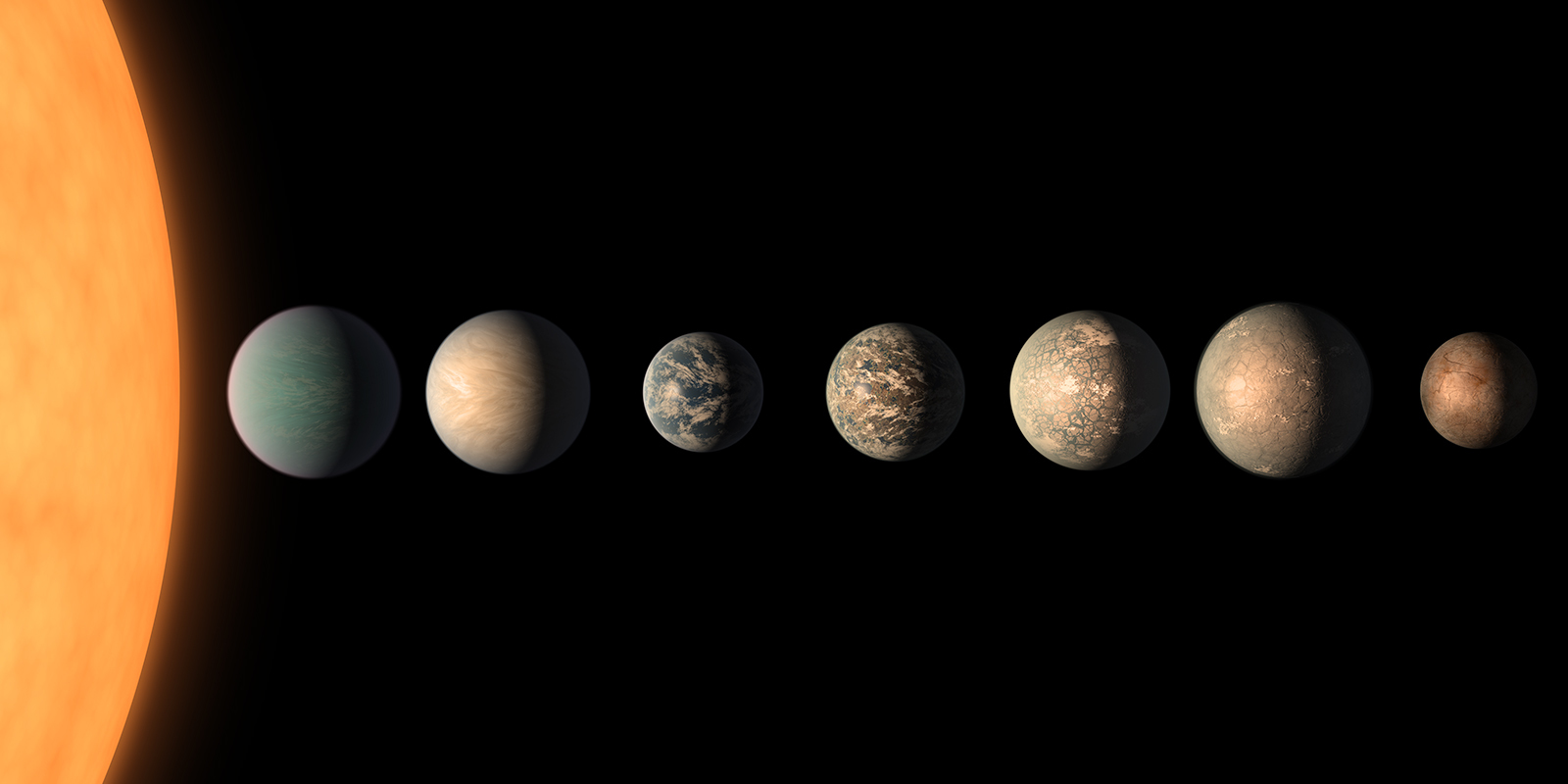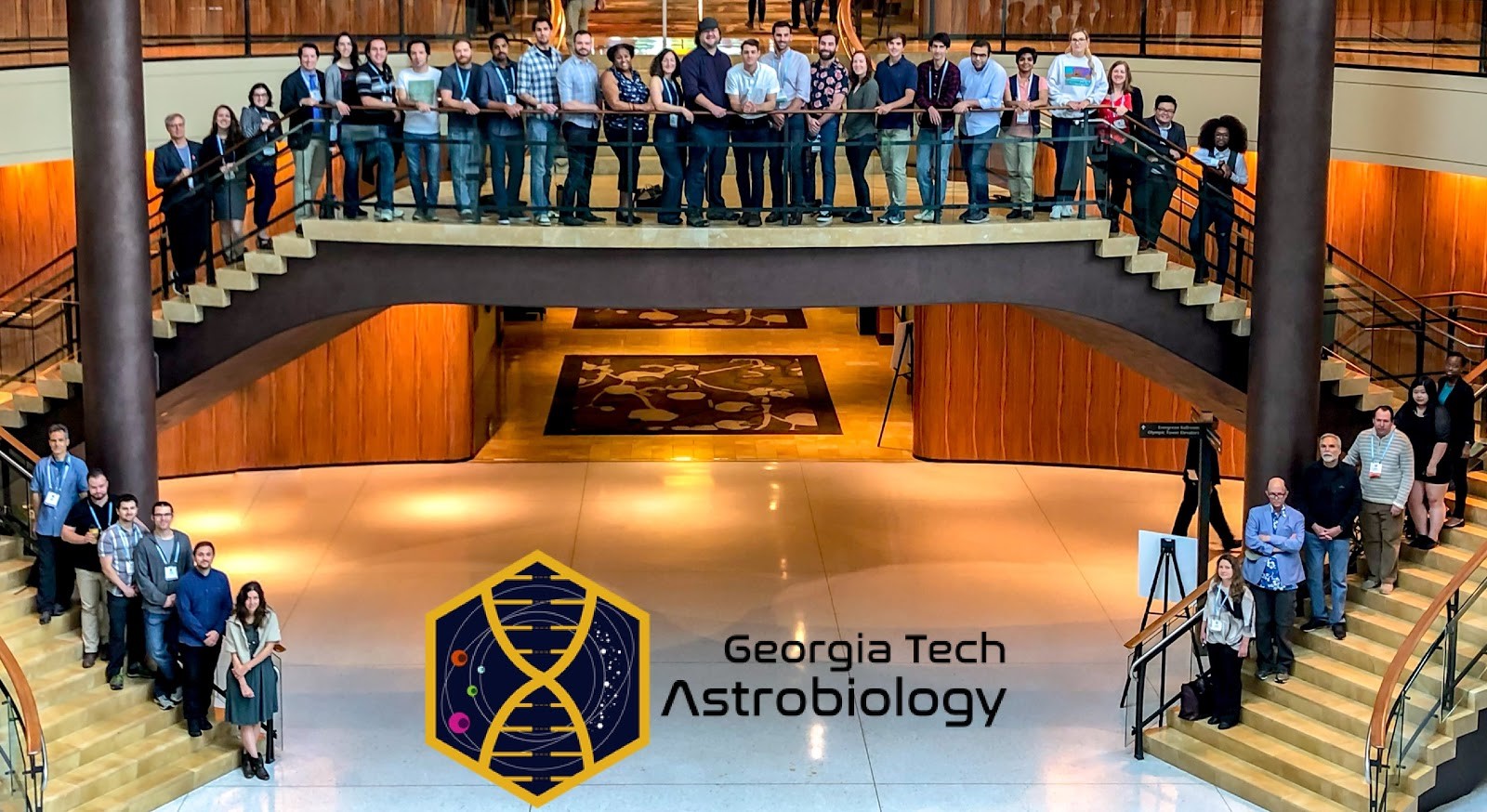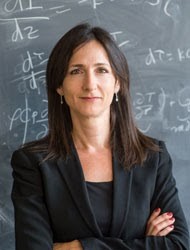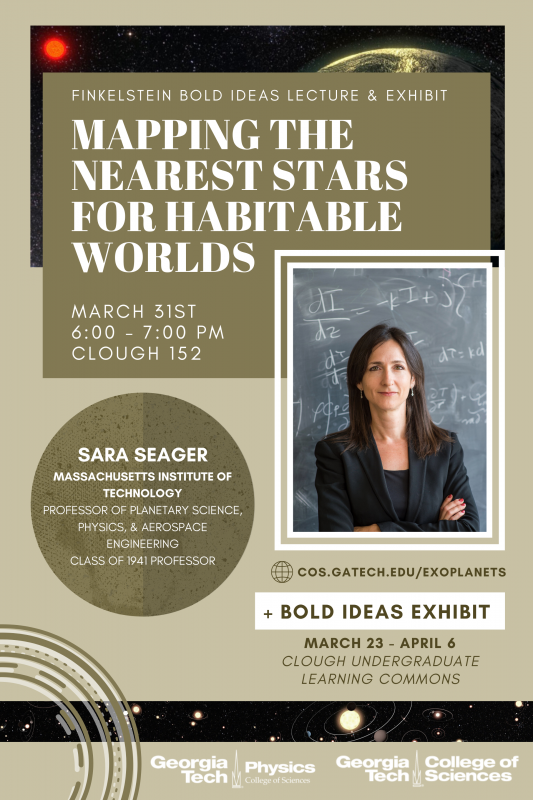
Mar 09, 2020 - Atlanta, GA
The David Ritz Finklestein Lecture series at Georgia Tech has an official title: “Bold Ideas in Physics.” And in 2016, just one year before the inaugural Finkelstein Lecture, there was nothing bolder than the idea that an astrobiology research community could not only exist at Georgia Tech, but thrive.
Beyond kickstarting degree programs and securing research funding, Tech’s Astrobiology Community has grown over a short few years to host conferences and bi-weekly meetups, welcome top lecturers and research talent, and invite new academic attention to a branch of biology that seeks to better understand life on earth and in space.
Recently, that evolution includes helping discover a new exoplanet right out of Star Wars, and booking MIT’s exoplanet hunter Sara Seager — billed by NASA as “an astronomical Indiana Jones” — for the 2020 Finklestein Lecture, set for the evening of March 31 in Clough Commons.
The 2020 Finkelstein Lecture with Sara Seager, originally scheduled for March 31, 2020, has been postponed. Please visit cos.gatech.edu for further updates.
How Did We Get Here — And Who Else Is Out There?
“Georgia Tech Astrobiology Center is newly formed, but it already involves many of the world leaders in astrobiology research in diverse fields ranging from origins chemistry to planetary sciences,” says Gongjie Li, assistant professor in the School of Physics. Li studies the creation and evolution of exoplanets, and also explores the interactions between stars and supermassive black holes.
That research is part of any astrobiologist’s mission: To try to answer longstanding questions about the cosmos. How did the elements form in the stars, and then become planets? How did life form on Earth, and how does that knowledge inform our search for life somewhere else in the universe?
That work has led to several major developments for the Georgia Tech Astrobiology community since its inception:
- Georgia Tech now has eight astrobiology-related research centers, including the Center for Chemical Evolution (CCE), the Center for Space and Technology Research (C-STAR), Oceans Across Space and Time (OAST,) and Radiation Effect on Volatiles and Exploration of Asteroids and Lunar Surfaces (REVEALS).
- NASA has one of its 10 NASA Astrobiology Institute (NAI) teams on campus.
- Partnerships with NASA and the National Science Foundation are providing funding for projects like the Icefin probe, a prototype of a robotic vehicle set to search for possible life in the icy waters of Jupiter’s moon Europa.
- In May 2019, the institute launched the Georgia Tech Astrobiology Graduate Certification Program, which links the Schools of Earth and Atmospheric Sciences, Chemistry and Biochemistry, Biological Sciences, the Daniel Guggenheim School of Aerospace Engineering, and the Sam Nunn School of International Affairs.
NASA TESS Mission: Finding The First World With Two Stars
Thousands of exoplanets – planets existing outside our solar system — have been discovered in the last 20 years. Georgia Tech astrobiology researchers can now add their names to the list of those doing the discovering.
Gongjie Li and Billy Quarles, a School of Physics postdoctoral candidate, are part of NASA’s Transiting Exoplanet Survey Satellite (TESS) mission, a group of researchers from colleges, research institutes and other science organizations who study data from the TESS probe. In early January, the group announced it had discovered what is called a circumbinary exoplanet, one that orbits two stars (think Tatooine, Luke Skywalker’s home planet, in the Star Wars films.)
Binary systems — planetary systems that have more than one star — are part of a research study published by Li and Quarles last November. It turned up data showing that 87 percent of exoplanets found in binary systems had similar axis tilts as Earth. That could make them good candidates for harboring life, since those tilts usually mean planetary climate stability.
David Ritz Finkelstein: “Bold Ideas in Physics” Exhibit
This and other Georgia Tech “Astrobio” discoveries and related research are featured in the “Bold Ideas in Physics” Exhibit, open to all from March 23 to April 6 in Clough Undergraduate Learning Center. The self-guided exhibit walks through three areas of Astrobiology at Tech and beyond:
- Research and discovery of exoplanetary systems, and to understanding how exoplanets form and if they are habitable — with a focus on their interactions with planets, which plays an important role in habitability.
“Our main research interest is the theoretical understanding of planet formation and dynamical evolution,” Li says.
- About the Georgia Tech Astrobiology Community and its unique potential for “building early career collaboration and expanding education and exposure for students interested in the fields of space technology development, astrobiology, planetary science, spacecraft and robotics design, cosmology, and origins of life research.
This area of the exhibit also highlights the diverse research community investigating the molecular origins and evolution of life, the evolution of the solar system, the nature and environments of potential targets for exploration, and the search for life beyond Earth, made possible by recent and ongoing NASA and National Science Foundation investments.
A third panel from the Clough exhibit not only highlights the efforts to look for life elsewhere in the universe, but the interdisciplinary efforts involved in that search. From the exhibit:
- “Astrobiology seeks to develop the technology and capabilities necessary to search for life beyond Earth. Many astrobiologists are involved in robotic field exploration, simulating the operations of vehicles that could one day visit the moons of Jupiter and Saturn — especially Titan, Europa and Enceledus — which contain oceans of liquid water that could host life. Because of the broad nature of the questions being asked, expertise from many different fields, from cosmology and planetary science, to biology and aerospace engineering, comes together in the search for life.”
Sara Seager: Exoplanet Hunter, 2020 Finkelstein Lecturer
Sara Seager is a living example of that interdisciplinary approach. She is the Class of 1942 Professor of Planetary Science at the Massachusetts Institute of Technology. She is also a professor of physics, and a professor of aeronautics and astronautics. Her search for life elsewhere involves theorizing about exoplanet atmospheres, and she conducted some of the earliest studies on that topic. She is currently developing ways for scientists in the near future to narrow down the search for extraterrestrial signs of life based on atmospheric biosignature gases.
Seager is the deputy science director for the TESS mission (MIT leads the mission for NASA.) She is also the lead and principal investigator for other space-based research missions.
“Mapping Our Nearest Stars for Habitable Worlds”
Seager is set to visit campus and share the latest advances in this revolutionary field and her exoplanet explorations on March 31, at 6 pm in Clough Undergraduate Learning Commons:
“Thousands of exoplanets are known to orbit nearby stars with evidence that nearly every star in our Milky Way Galaxy has planets,” Seager says. “Beyond their discovery, a new era of ‘exoplanet characterization’ is underway with an astonishing diversity of exoplanets driving the fields of planetary science and engineering to new frontiers. The push to find smaller and smaller planets down to Earth size is succeeding and motivating the next generation of space telescopes to have the capability to find and identify small planets by suppressing the starlight to observe the planet directly. The ultimate goal is to discover planets that may have suitable conditions for life or even signs of life by way of atmospheric biosignature gases.”
All are welcome to attend the 2020 Finkelstein Bold Ideas Lecture and Exhibit.
The 2020 Finkelstein Lecture with Sara Seager, originally scheduled for March 31, 2020, has been postponed. Please visit cos.gatech.edu for further updates.
The Bold Ideas in Physics series celebrates the life and work of David Ritz Finkelstein, the late Georgia Tech School of Physics professor who was unafraid to challenge orthodoxy (and the first to show, at age 29, that anything falling inside a black hole cannot escape — as well as one of the first in his field to bring topology into quantum physics). Learn more



